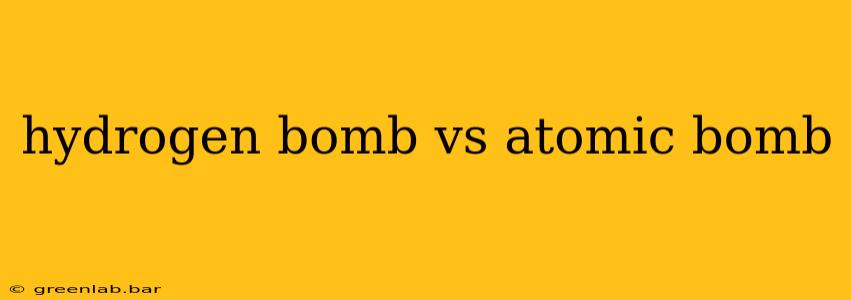The terms "atomic bomb" and "hydrogen bomb" are often used interchangeably, leading to confusion about their fundamental differences. While both are devastating weapons of mass destruction, their mechanisms, destructive power, and long-term consequences differ significantly. This article delves into the core distinctions between these two types of nuclear weapons.
The Atomic Bomb (Fission Bomb): Unleashing Nuclear Fission
An atomic bomb, also known as a fission bomb, derives its destructive power from nuclear fission. This process involves splitting the nucleus of a heavy atom, such as uranium-235 or plutonium-239, into smaller nuclei. This splitting releases an immense amount of energy, primarily in the form of heat and radiation. The chain reaction, where one fission event triggers others, creates a rapid, explosive release of energy.
Key Characteristics of Atomic Bombs:
- Mechanism: Nuclear fission.
- Fuel: Uranium-235 or Plutonium-239.
- Yield: Relatively lower compared to hydrogen bombs (kilotons of TNT equivalent).
- Fallout: Significant radioactive fallout due to the fission products.
- Examples: The bombs used in Hiroshima and Nagasaki were atomic bombs (uranium and plutonium, respectively).
The Hydrogen Bomb (Thermonuclear Bomb): Harnessing Nuclear Fusion
A hydrogen bomb, also called a thermonuclear bomb, employs a different principle: nuclear fusion. This process involves fusing light atomic nuclei, such as isotopes of hydrogen (deuterium and tritium), into a heavier nucleus, such as helium. This fusion reaction releases even more energy than fission, resulting in significantly greater explosive power.
Crucially, a hydrogen bomb typically uses a fission bomb as a trigger. The fission explosion provides the extreme heat and pressure necessary to initiate the fusion reaction. This is why hydrogen bombs are often called "two-stage" weapons.
Key Characteristics of Hydrogen Bombs:
- Mechanism: Nuclear fusion (triggered by nuclear fission).
- Fuel: Deuterium and tritium (isotopes of hydrogen).
- Yield: Significantly higher than atomic bombs (megatons of TNT equivalent).
- Fallout: Can produce less fallout than fission bombs, depending on the design, though still significant.
- Examples: Many modern nuclear weapons are hydrogen bombs or variations thereof.
Comparing the Two: A Table Summary
| Feature | Atomic Bomb (Fission) | Hydrogen Bomb (Fusion) |
|---|---|---|
| Mechanism | Nuclear Fission | Nuclear Fusion (triggered by Fission) |
| Fuel | Uranium-235, Plutonium-239 | Deuterium, Tritium |
| Yield | Kilotons of TNT | Megatons of TNT |
| Radioactive Fallout | High | Potentially lower (depending on design) |
| Complexity | Relatively simpler | Significantly more complex |
The Devastating Consequences: Beyond the Blast
Both atomic and hydrogen bombs cause widespread destruction through a combination of:
- Blast wave: The initial shockwave causes immense damage to structures and infrastructure.
- Thermal radiation: Intense heat causes burns and ignites fires over a wide area.
- Nuclear radiation: Both bombs emit harmful ionizing radiation, leading to acute radiation sickness, long-term health problems, and genetic damage. This radiation is more persistent and widespread with fission bombs due to the fallout.
Conclusion: A Stark Reminder of Nuclear Power
The differences between atomic and hydrogen bombs are significant, with hydrogen bombs possessing vastly superior destructive power. Understanding these distinctions highlights the catastrophic potential of nuclear weapons and the urgent need for global efforts towards nuclear disarmament. The legacy of these weapons continues to impact the environment and human health for generations.

